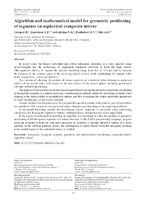| dc.contributor.author | Conquet, B. | |
| dc.contributor.author | Zambrano, L. F. | |
| dc.contributor.author | Artyukhina, N. K. | |
| dc.contributor.author | Fiodоrtsev, R. V. | |
| dc.contributor.author | Silie, A. R. | |
| dc.coverage.spatial | Минск | ru |
| dc.date.accessioned | 2018-09-18T08:15:16Z | |
| dc.date.available | 2018-09-18T08:15:16Z | |
| dc.date.issued | 2018 | |
| dc.identifier.citation | Algorithm and mathematical model for geometric positioning of segments on aspherical composite mirror = Алгоритм и математическая модель геометрического позиционирования асферического составного зеркала / B. Conquet [et al.] // Приборы и методы измерений : научно-технический журнал. - 2018. – Т. 9, № 3. – С. 234-242. | ru |
| dc.identifier.uri | https://rep.bntu.by/handle/data/47612 | |
| dc.description.abstract | In recent years, the largest terrestrial and orbital telescopes operating in a wide spectral range of wavelengths use the technology of segmented composite elements to form the main mirror. This approach allows: to expand the spectral operating range from 0.2 to 11.0 μm and to increase the diameter of the entrance pupil of the receiving optical system, while maintaining the optimal value of the exponent mₛ – mass per unit area. Two variants of adjusting the position of mirror segments are considered when forming an aspherical surface of the second order, with respect to the base surface of the nearest sphere, including geometrical and opto-technical positioning. The purpose of the research was to develop an algorithm for solving the problem of geometric positioning of hexagonal segments of a mirror telescope, constructing an optimal circuit for traversing elements when aligning to the nearest radius to an aspherical surface, and also to program the output calculation parameters to verify the adequacy of the results obtained. Various methods for forming arrays from regular hexagonal segments with equal air gaps between them are considered. The variant of construction of arrays through concentric rings of an equal step is offered. A sequential three-step method for distributing mosaic segments is presented when performing calculations for aligning the aspherical surface: multipath linear; multipath point; block trapezoidal. In the course of mathematical modeling an algorithm was developed to solve the problem of geometric positioning of flat hexagonal segments of a mirror telescope. In the Python programming language, program loops are designed to form the data array necessary to construct a specular reflective surface of a given aperture. In the software package Zemax, the convergence of optical beams from flat hexagonal elements to the central region of the aspherical surface is verified. | ru |
| dc.language.iso | en_US | ru |
| dc.publisher | БНТУ | ru |
| dc.title | Algorithm and mathematical model for geometric positioning of segments on aspherical composite mirror | ru |
| dc.title.alternative | Алгоритм и математическая модель геометрического позиционирования асферического составного зеркала | ru |
| dc.type | Article | ru |
| dc.identifier.doi | 10.21122/2220-9506-2018-9-3-234-242 | |
| local.description.annotation | В последние годы крупнейшие наземные и орбитальные телескопы, работающие в широком спектральном диапазоне длин волн, при формировании главного зеркала используют технологию сегментированных составных элементов. Такой подход позволяет: расширить спектральный рабочий диапазон от 0,2 до 11,0 мкм и увеличить диаметр входного зрачка приемной оптической системы, при сохранении оптимального значения показателя mₛ – масса на единицу площади. Цель исследований заключалась в разработке алгоритма для решения задачи геометрического позиционирования гексагональных сегментов зеркального телескопа, построения оптимальной схемы «обхода» элементов при юстировке на ближайший радиус к асферической поверхности, а также программной апробации выходных расчетных параметров с целью проверки адекватности полученных результатов. Рассмотрены два варианта юстировки положения зеркальных сегментов при формировании асферической поверхности второго порядка, относительно базовой поверхности ближайшей сферы, включающие геометрическое и оптотехническое позиционирование. Рассмотрены различные методики формирования массивов из регулярных шестиугольных сегментов с равными воздушными промежутками между ними. Предложен вариант построения массивов через концентрические кольца равного шага. Представлена последовательная трехступенчатая методика распределения сегментов мозаики при выполнении расчетов по юстировке асферической поверхности: многолучевая линейная; многолучевая точечная; блочная трапецеидальная. В ходе проведения математического моделирования разработан алгоритм для решения задачи геометрического позиционирования плоских гексагональных сегментов зеркального телескопа. На языке программирования Python составлены циклы программы для формирования массива данных необходимых для построения зеркальной отражающей поверхности заданной апертуры. В программном пакете Zemax выполнена проверка сходимости оптических лучей от плоских гексагональных элементов в центральную область асферической поверхности. | ru |

